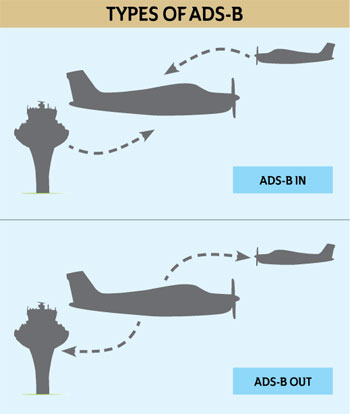Air Space Management Solution for Safer and Efficient Travel
ADS-B provides more accurate positioning of the aircraft on real time basis with which ATCs can better manage the flow of the air traffic by reducing aircraft separation

Several major countries around the world are implementing a technology called Automatic Dependent Surveillance–Broadcast (ADS-B) that helps to better track the location of an aircraft and enhance global safety within Air Traffic Services (ATS). The reason is that regulators wanted to implement a tracking and air space management solution which is environmentally friendly, enhances safety as compared to existing radar based systems and directly benefits pilots, controllers, airports and the airlines. The purpose of this article is to provide a simple understanding of this technology and how it benefits the aviation ecosystem.
WHAT IS ADS-B?
ADS-B is a surveillance technology which allows equipped aircraft and ground vehicles to broadcast their identification, position, altitude and velocity to other aircraft and the Air Traffic Controllers (ATCs) on ‘real-time’ basis. The technology may eventually replace radar as the primary surveillance method for Air Traffic Control (ATC) monitoring and separation of aircraft worldwide.
ADS-B consists of two different services – “ADS-B OUT” and ADS-B-IN”.
With ADS-B OUT, the aircraft broadcasts its identification, position, altitude and velocity on real time basis to other aircraft and the ATCs.With ADS-B IN, the aircraft is able to receive the above information from other aircraft including weather data and pilot reports. This provides more situational awareness for pilots and air traffic controllers.
Further, to receive ADS-B IN services from the ground network, aircraft must broadcast valid ADS-B Out messages. Hence ADS-B OUT is or will become mandatory, whereas ADS-B IN is not mandatory.
From an overall technical perspective ADS-B has three main components:
Ground infrastructure: The ADS-B data transmitted by the aircraft or airport vehicles are received by the ADS-B ground stations. The output of the ADS-B ground stations is processed by surveillance data processing and distribution systems along with radar sensory systems to create a possibly seamless, accurate and reliable Air Situation or Air Traffic Picture.
Airborne components: The “ADS-B Out” capability on board is enabled by transponders interfaced with the relevant avionics systems (such as GNSS, pressure altimeters etc.). Many aircraft have ADS-B 1090 MHz Mode S Extended Squitter technology that is used worldwide to ensure global interoperability.
The “ADS-B In” capability requires a receiver, a processing system and a display system for providing traffic and hazardous weather system.
Operating procedures: Operating procedures include processes and ADS-B specific phraseology to be followed by all stakeholders (pilots, ATCs, airports) required for safe and structured communication over ADS-B system. The operational use of ADS-B requires certification and operational approval by the regulatory authorities.
WHAT ARE THE BENEFITS OF ADS-B?
Of the several ones, ADS-B provides three broad benefits:

Safety: ADS-B provides high level of situational awareness as pilots have the ability to assess real time position of other aircraft in their vicinity (equipped with ADS-B OUT) as well have access to weather information.
Airspace capacity and efficiency: As ADS-B provides more accurate positioning of the aircraft on real time basis, ATCs can better manage the flow of the air traffic by reducing aircraft separation, leading to better management of airspace capacity.
Reduced environmental impact: ADS-B reduced the requirement for aircraft separation. In addition, it increases the ability of the pilots to self-separate and enhances their visual approaches. This allows ATCs to guide aircraft into and out of crowded airspace with smaller separation standards than it was previously possible to do safely. Airplanes are able to perform Continuous Descent Approaches (CDAs) which reduces fuel consumption and noise compared to other conventional descents. As this reduces aircraft waiting time for clearances, there is a tangible impact on fuel savings and noise pollution.
HOW IS INDIA PREPARED FOR ADS-B IMPLEMENTATION?
Per 2019 ICAO Working Paper on India’s plan and progress on implementation of ADS-B surveillance and data sharing activities, India has installed 31 ADS-B sensors out of which 29 are installed in the mainland and one each in Port Blair Island and Campbell Bay Island in Bay of Bengal. ADS-B ground receivers have been installed for enroute surveillance services and for approach control surveillance services at major and minor city airports.
WHAT ARE THE IMPLEMENTATION TIMELINES?
Countries such as USA (within defined airspace) and India have mandated ADS-B OUT implementation from January 1, 2020 onwards, but have been accommodating change in implementation schedule.
India: The ADS-B mandate across Indian airspace was due to take effect on 1st January 2019. However, it is expected that the implementation will happen in last quarter of 2022. As of now, aircraft flying on performance based navigation routes almost everywhere in Indian continental airspace at or above an altitude of 29,000 feet must carry serviceable 1090 MHz ES ADS-B transmitting equipment.
ADS-B is the technology that will help aviation become more safe, efficient and sustainable. Hence a global concerted effort on implementation of this technology could go a long way in creating a better future for aviation.





